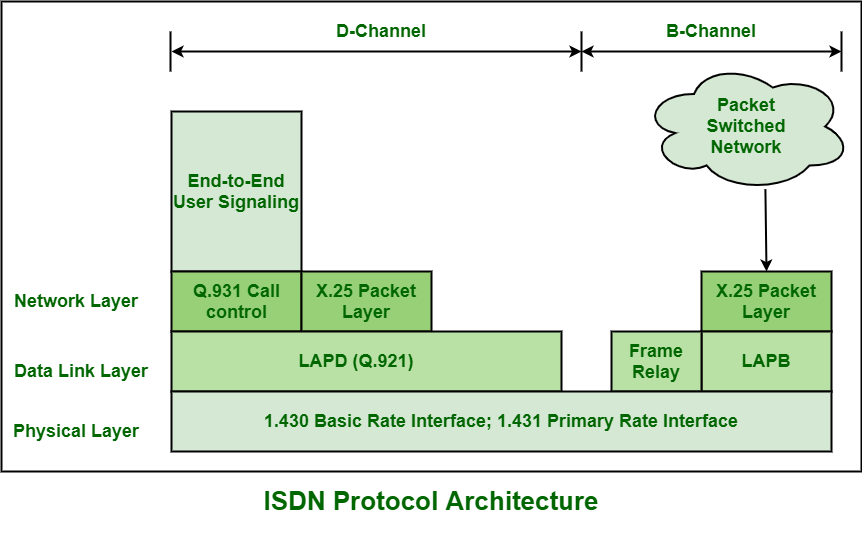ISDN Protocol Architecture
Integrated Services Digital Network (ISDN) is simply considered as general-purpose digital network that is being capable of highly and fully supporting wide range of services like voice, data, text, and image with the help of very small set of standard multipurpose user-network interfaces. It is also useful in providing very useful framework for development and establishment of future telecommunications networks and services.
Previously, it is known as Integrated Digital Network (IDN) which is basically standardization digital technique for switching and transmission. ISDN also supports two types of switching operations i.e., circuit-switched operations and packet-switched operations. ISDN protocol architecture takes care of both of these switching operations. Circuit Switching is provided at the very nominal bit rate of 64 kbps whereas packet switching is provided for wide range of bit rates up to 64 kbps.

Types of Channels :
ISDN generally contains three types of channels i.e., B-channel (Bearer channel), D-channel (Data Channel), and H-channel (Hybrid Channel).
- B-Channel :
B-channel usually has 64 kbps data rate. This channel is required for voice, data, or other low data rate information. For higher data rates, two B-channel will get combined to give total of 128 kbps data rates.
- D-Channel :
D-channel usually has 16 to 64 kbps data rate. This channel is required for signaling or packet-switched data. D-channel does not even carry data. It is simply required for carrying all of the controlling signals as establishing call, ringing, call interrupt, etc. It is common channel signaling that carries control signals for all of the using out-band signaling. Using this channel subscribes generally provide security to B connection. It is also required to carry data or information as videotext, tele-text, emergency services alarms, etc. in case of no signaling.
- H-Channel :
H-channel generally has kbps, 1536 kbps, or 1920 kbps data rate. This channel is required for video, video-conferencing, high-speed data/audio, etc.
Types of Layers :
ISDN usually contains two different layering mechanisms out of which one is for B/H Channels and other one for D Channel. For D-channel, ISDN contains three-layered protocol architecture. On the other hand, for B-channel, ISDN contains only one protocol layer i.e. physical layer and rest of upper layers are dependent on the application.
- Physical Layer :
At this layer, B and D channels are same and uses either BRI or PRI Interface. It defines various primary aspects such as mechanical and electrical specifications of interface R, S, T, and U, Encoding, or power supply, etc. It is also based in X.21 for interfacing with public circuit switching network through an 8-pin connector.
- Data Link Layer :
At this layer, B or D Channel generally uses LAPB or LAPD. B and D channels use different data link protocols i.e. LAPB For B channel and LAPD for D channel.
- Network Layer :
At this channel, B-channel has different options in connecting to circuit either circuit-switched, packet-switched, frame relay, or ATM networks.


